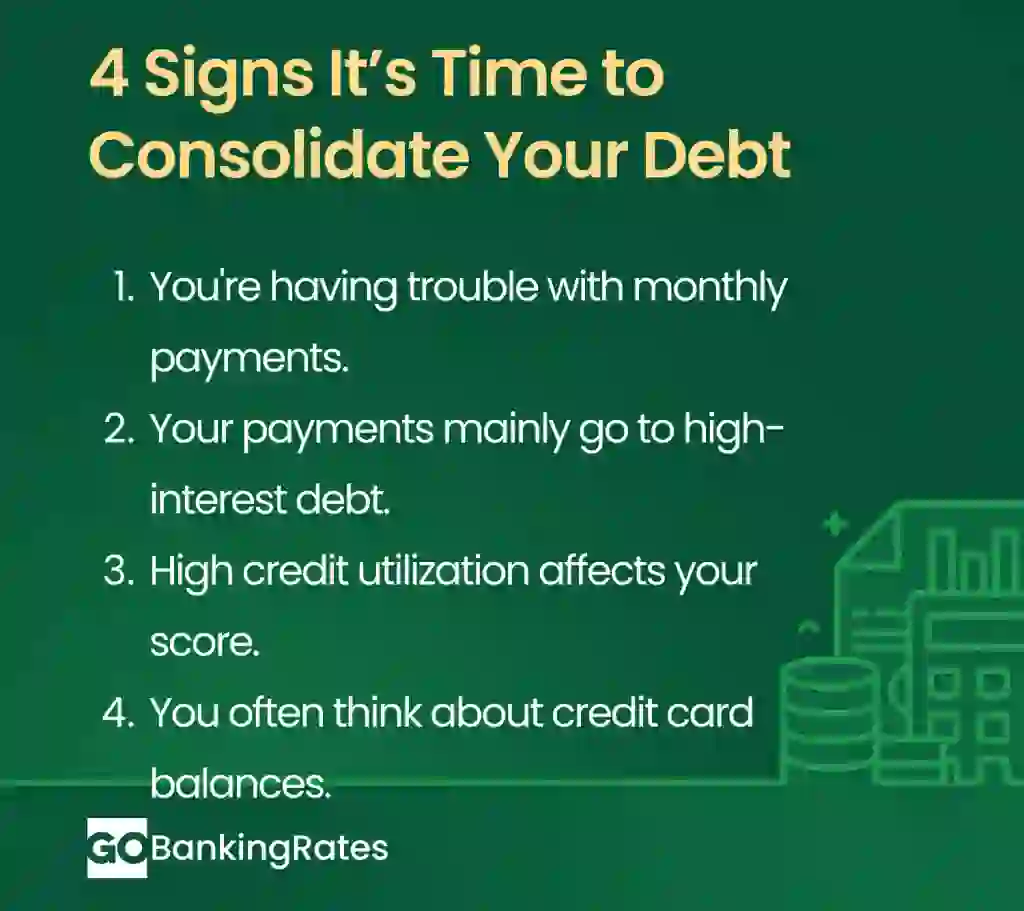How To Consolidate Credit Card Debt

Commitment to Our Readers
GOBankingRates' editorial team is committed to bringing you unbiased reviews and information. We use data-driven methodologies to evaluate financial products and services - our reviews and ratings are not influenced by advertisers. You can read more about our editorial guidelines and our products and services review methodology.

20 Years
Helping You Live Richer

Reviewed
by Experts

Trusted by
Millions of Readers
Consolidating credit card debt is the act of combining multiple credit card balances into one. The result can be a single, more manageable monthly payment. The best debt consolidation loans often come with a lower interest rate.
How To Consolidate Credit Card Debt in 5 Steps
Consolidating your credit card debt is less complicated than you might think. Just follow these simple steps.
1. List All Your Credit Cards and Balances
It’s important to know exactly how much debt you’re dealing with. The total amount can affect your final decision for how to consolidate it. For example, if you’ve got $40,000 in balances, you probably won’t be able to throw that on a balance transfer credit card.
2. Check Your Credit Score
Your list of options is largely dictated by your credit score. For instance, you likely won’t qualify for an installment loan if you’ve got a sub-600 credit score.
Similarly, a balance transfer credit card will only hold as much as its credit line will allow. If your credit score is bad, you probably won’t be able to transfer a meaningful amount of debt to it.
3. Choose the Right Consolidation Method
You’re looking for the plan that will help you pay off your debts the fastest with minimal negative impact to your credit score.
Again, balance transfer credit cards, personal loans and home equity loans will all likely cause short-term dips but quickly improve your score.
A debt management plan can have the most negative impact on your credit, but it’s nice to have the option when if you’ve run out of other alternatives.
4. Apply and Move Your Debt
Open your new account and relocate your debt. For balance transfer cards, this will mean sharing with the issuer your debt-filled credit card numbers. For personal and home equity loans, you’ll often receive a lump sum of money that you can use to zero out your credit cards.
5. Stick to Your New Payment Plan
Use your current credit responsibly and make the minimum payments for your new loan on-time. Your credit score will improve.
What Are the Best Ways To Consolidate Credit Card Debt?
There are multiple ways to consolidate your credit card balances. Here’s a rundown for how to consolidate credit card debt without hurting your credit.
| Loan Type | Best For | Interest | Ease of Use | Credit Impact |
|---|---|---|---|---|
| Balance transfer credit cards | Those with good credit scores | 0% intro APR for up to 24 months, then typically variable rates up to 29% | – Quick online application – Balances may take a few weeks to transfer – Pay off at your leisure, though minimum payments are still required |
Credit score will temporarily drop slightly from opening a new card, but quickly bounce back. |
| Personal loans | Those who want fixed monthly payments with a definite payoff date | Generally between 6% and 27% APR, depending on your credit score and other factors | – Quick online application – Cash often deposited within a few days – Straightforward monthly installments |
Credit score will temporarily drop slightly from opening a new account, but can shoot up from a reduced credit utilization. |
| Home equity loans | Homeowners with equity willing to use their house as collateral | Generally between 6% and 24% APR | May require more than an application, including appraisal and closing costs | Credit score will temporarily drop slightly from opening a new account, but can shoot up from a reduced credit utilization. |
| Debt management plan (DMP) | Those with bad credit who don’t foresee a way to pay down debts | Potentially reduced from your current credit card APR | – Requires credit counseling – New loan arranged by a credit counseling agency – Accounts being rolled into the DMP must be closed |
Credit utilization will likely spike as your credit card accounts are closed. |
Pros and Cons of Consolidating Credit Card Debt
If you’re considering credit card debt consolidation, the best way to consolidate credit card debt varies depending on your situation. Here are the pros and cons of debt consolidation.
Pros:
- Easier to manage your monthly payments
- Reduced interest rates
- Potential credit score improvement
Cons:
- Upfront fees — sometimes
- May not work for poor credit
- Enables you to accrue more debt if spending isn’t controlled
Should You Close Your Credit Card Accounts After Consolidating?
If an open credit card tempts you into overspending, it’s best to keep your credit card accounts open after consolidating. There are multiple reasons for this, including:
- Keeping a low credit utilization: The ratio of your total available credit to the amount you owe is a huge factor in your credit score. Close your credit cards, and your total available credit goes down.
- Maintain a lengthy credit history: When you close longstanding credit cards, your average account age will decrease, which can hurt your credit score.
- More opportunities to exhibit good credit habits: The more credit cards you have, the more on-time monthly payments you can make. Of course, you shouldn’t rack up more debt on your credit cards, but using them all periodically can help bolster your credit profile.

Is Credit Card Consolidation the Right Move for You?
Depending on your financial situation, some of these strategies work and some won’t. Here’s how to tell:
When Consolidation Works Best
- You’re struggling with high-interest debt.
- You have a decent credit score, so you can qualify for good interest rates.
- You have a steady income and can pay back your loan on time.
When To Avoid Consolidation
- Your credit score is too low and you have a hard time opening a new account.
- You don’t have stable income right now — it may still be aa struggle to pay back a consolidated loan.
- You’re missing or behind on payments and can’t afford bills. A debt management plan may likely be a better option.
What’s the Next Step? Taking Charge of Your Debt
You shouldn’t get a debt consolidation loan if you’re unwilling to change your previous spending habits.
Remember, this is your chance to repair your credit and eliminate debt. If you overspend again, you’ll find yourself making monthly payments on your new loan and high-interest credit cards.
Ana Gotter contributed to the reporting for this article.
Our in-house research team and on-site financial experts work together to create content that’s accurate, impartial, and up to date. We fact-check every single statistic, quote and fact using trusted primary resources to make sure the information we provide is correct. You can learn more about GOBankingRates’ processes and standards in our editorial policy.
- Consumer Financial Protection Bureau (CFPB. 2023. "What do I need to know about consolidating my credit card debt?"
- Federal Trade Commission (FTC). "How To Get Out of Debt."
- Capital One. 2024. "What credit score do you need for a personal loan?"
- U.S. Bank. 2025. "Consolidating debts: Pros and cons to keep in mind."
- CFPB. 2024. "How do I get and keep a good credit score?"
 Written by
Written by  Edited by
Edited by 





















